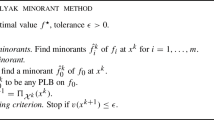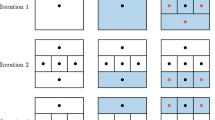Abstract
We introduce a new algorithm for the continuous bounded quadratic knapsack problem. This algorithm is motivated by the geometry of the problem, is based on the iterative solution of a series of simple projection problems, and is easy to understand and implement. In practice, the method compares favorably to other well-known algorithms (some of which have superior worst-case complexity) on problem sizes up ton = 4000.
Similar content being viewed by others
References
A.V. Aho, J.E. Hopcroft and J.D. Ullman,The Design and Analysis of Computer Algorithms (Addison-Wesley, Reading, MA, 1974).
A. Ali, R. Helgason, J. Kennington and H. Lall, “Computational comparison among three multicommodity network flow algorithms,”Operations Research 28 (1980) 995–1000.
P. Brucker, “An O(n) algorithm for quadratic knapsack problems,”Operations Research Letters 3 (1984) 163–166.
R.W. Cottle, S.G. Duvall and K. Zikan, “A Lagrangean relaxation algorithm for the constrained matrix problem,”Naval Research Logistics Quarterly 33 (1986) 55–76.
S.C. Dafermos and F.T. Sparrow, “The traffic assignment problem for a general network,”Journal of Research of the National Bureau of Standards 73B (1969) 91–118.
J. Dussault, J. Ferland and B. Lemaire, “Convex quadratic programming with one constraint and bounded variables,”Mathematical Programming 36 (1986) 90–104.
M. Held, P. Wolfe and H.P. Crowder, “Validation of subgradient optimization,”Mathematical Programming 6 (1974) 62–88.
R. Helgason, J. Kennington and H. Lall, “A polynomially bounded algorithm for a singly constrained quadratic program,”Mathematical Programming 18 (1980) 338–343.
G.T. Herman and A. Lent, “A family of iterative quadratic optimization algorithms for pairs of inequalities, with application in diagnostic radiology,”Mathematical Programming Study 9 (1978) 15–29.
J.V. Jucker and C. de Faro, “A simple algorithm for Stone's version of the portfolio selection problem,”Journal of Financial and Quantitative Analysis 10 (1975) 859–870.
N. Katoh, T. Ibaraki and H. Mine, “A polynomial time algorithm for the resource allocation problem with a convex objective function,”Journal of the Operational Research Society 30 (1979) 449–455.
C. Michelot, “A finite algorithm for finding the projection of a point onto the canonical simplex of ℝn,”Journal of Optimization Theory and Applications 50 (1986) 195–200.
J.J. Moré and G. Toraldo, “Algorithms for bound constrained quadratic programming problems,”Numerische Mathematik 55 (1989) 377–400.
A. Nagurney, D.S. Kim and A.G. Robinson, “Serial and parallel equilibration of large-scale constrained matrix problems with application to the social and economic sciences,”The International Journal of Supercomputer Applications 4 (1990) 49–71.
A. Nagurney and A.G. Robinson, “Equilibration operators for the solution of constrained matrix problems,” to appear in:Mathematical and Computer Modelling.
A. Ohuchi and I. Kaji, “Lagrangian dual coordinatewise maximization algorithm for network transportation problems with quadratic costs,”Networks 14 (1984) 515–530.
J.S. Pang, “A new and efficient algorithm for a class of portfolio selection problems,”Operations Research 28 (1980) 754–767.
P.M. Pardalos and N. Kovoor, “An algorithm for a singly constrained class of quadratic programs subject to upper and lower bounds,”Mathematical Programming 46 (1990) 321–328.
W.H. Press, B.P. Flannery, S.A. Teukolsky and W.T. Vetterling,Numerical Recipes: The Art of Scientific Computing (Cambridge University Press, Cambridge, England, 1986).
Author information
Authors and Affiliations
Rights and permissions
About this article
Cite this article
Robinson, A.G., Jiang, N. & Lerme, C.S. On the continuous quadratic knapsack problem. Mathematical Programming 55, 99–108 (1992). https://doi.org/10.1007/BF01581193
Received:
Revised:
Issue Date:
DOI: https://doi.org/10.1007/BF01581193




